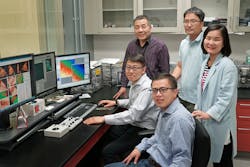New Cathode Material Triples the Energy Storage of Lithium-Ion Batteries
As the demand for smartphones, electric vehicles, and renewable energy continues to rise, researchers are searching for ways to improve lithium-ion batteries—the most common type of battery found in home electronics and a potential way to store grid-scale energy. A team of scientist at Brookhaven National Laboratory have found a way to boost the energy density of lithium-ion batteries, which could lead to longer-lasting batteries and expand the use of wind and solar energy.
The team, which also includes scientists at the University of Maryland and the U.S. Army Research Lab, has developed a cathode material that could triple the energy density of lithium-ion battery electrodes.
“Lithium-ion batteries consist of an anode and a cathode,” says Xiulin Fan, a lead scientist on the team. “And cathode materials are always the bottleneck for further improving the energy density of lithium-ion batteries.”
The team synthesized a new cathode material, a modified form of iron trifluoride (FeF3), which is composed of iron and fluorine—inexpensive and environmentally benign elements that are known to have inherently higher capacities than traditional cathode materials. Materials normally used in lithium-ion batteries are based on intercalation chemistry; while efficient, it only transfers a single electron, thus limiting the cathode. Compounds such as FeF3, however, can transfer several electrons through a more complex reaction mechanism known as a conversion reaction.
Despite FeF3’s potential to increase cathode capacity, the compound has not worked well in lithium-ion batteries in the past due to three complications with its conversion reaction: poor energy efficiency (hysteresis), a slow reaction rate, and side reactions that can degrade its cycling life. To overcome these challenges, the scientists added cobalt and oxygen atoms to FeF3 nanorods through a process called chemical substitution. This let the scientists manipulate the reaction pathway and make it more “reversible.”
Substituting the cathode material with oxygen and cobalt prevents lithium from breaking chemical bonds and preserves the material’s structure.
When lithium ions are inserted into FeF3, the material converts to iron and lithium fluoride. However, the reaction is not fully reversible. But after substituting with cobalt and oxygen, however, the reaction becomes more reversible.
To investigate the reaction pathway, scientists conducted several experiments. First, they used a powerful beam of electrons and a technique called transmission electron microscopy (TEM) to look at the FeF3 nanorods at a resolution of 0.1 nanometers. This let the researchers determine the exact size of nanoparticles in the cathode and analyze how the cathode changed in different phases of the charge-discharge process. They saw faster reactions in the substituted nanorods.
“TEM is a powerful tool for characterizing materials at very small lengths, and it can also investigate reaction processes in real time,” says Dong Su, a scientist on the team. “However, we can only see a limited area of the sample using TEM. We needed synchrotron techniques to understand how the whole battery functions.”
So, the team sent ultra-bright x-rays through the cathode material. By analyzing how the light scattered, the team could uncover additional information about the material’s structure. Further analysis then revealed that the team’s chemical substitution promotes electrochemical reversibility.
The researchers also performed advanced computational approaches based on density functional theory to decipher the reaction mechanism at an atomic scale. This revealed that chemical substitution shifted the reaction to a highly reversible state by reducing the particle size of iron and stabilizing the rocksalt phase. This research strategy could be applied to other high-energy conversion materials and improve other types of batteries.


